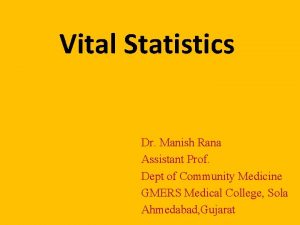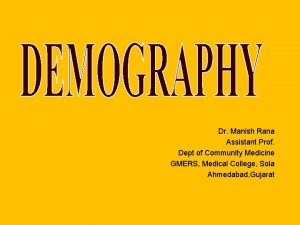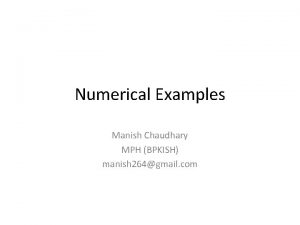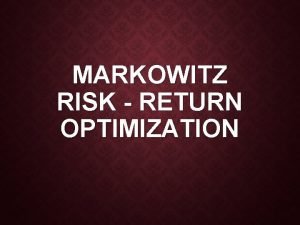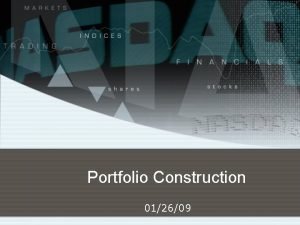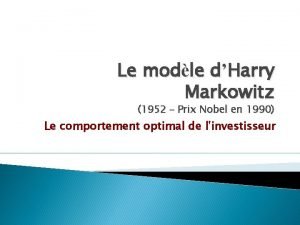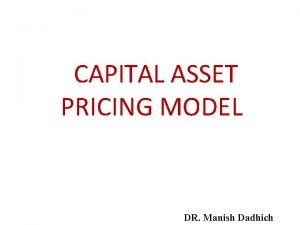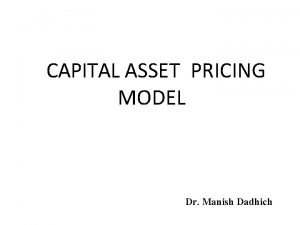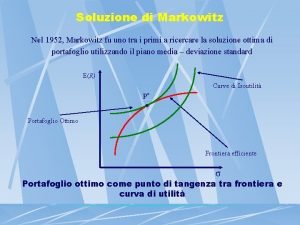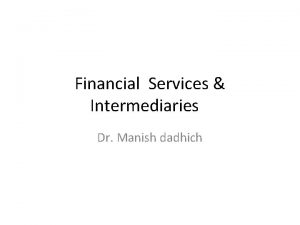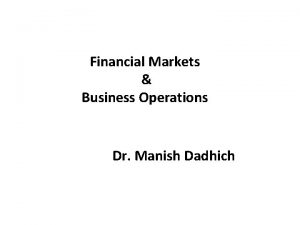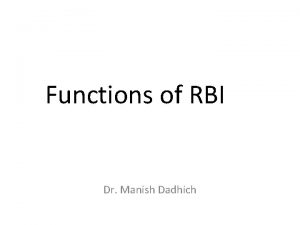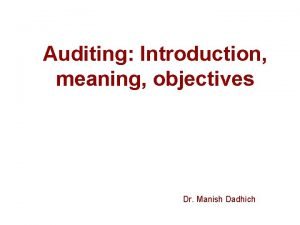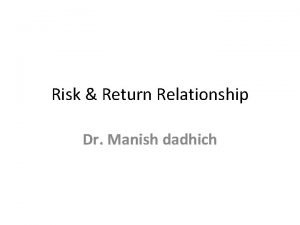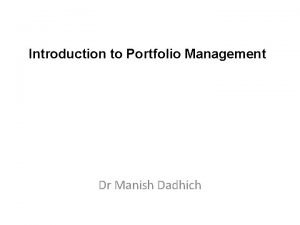Markowitz Model Dr Manish Dadhich 1 Markowitz Model












- Slides: 12

Markowitz Model Dr. Manish Dadhich 1

Markowitz Model Ø It assists in the selection of the most efficient by analyzing Ø Ø various possible portfolios of the given securities. By choosing securities that do not 'move' exactly together, the HM model shows investors how to reduce their risk. Also known as Mean-Variance Model. We all agree that holding two stocks is less risky as compared to one stock. But building the optimal portfolio is very difficult. Markowitz provides an answer to it with the help of risk and return relationship. Determination of a set of efficient portfolios. Selection of the best portfolio out of the efficient set.

Assumption & concept • Assumptions: • Risk of a portfolio is based on the variability of returns from the said portfolio. • An investor is always risk averse. • An investor prefers to increase consumption. • The investor's utility function is concave and increasing, due to his risk aversion and consumption preference. • Analysis is based on single period model of investment. • An investor either maximizes his portfolio return for a given level of risk or maximizes his return for the minimum risk. • An investor is rational in nature.

Concept • Concept: In developing the model, Markowitz has given up the single stock portfolio and introduced diversification. • The single stock portfolio would be preferable if the investor is perfectly certain that his expectation of higher return would turn out to be real. • But in this era of uncertainty most of the investors would like to join Markowitz rather than single stock. It can be shown with the help of example. 4

Stock ABC Stock XYZ Return % 11 or 17 20 or 8 Probability . 5 each return Expected return 14 14 Variance 9 36 Standard deviation 3 6 ABC expected return: . 5 x 11+. 5 x 17= 14 XYZ expected return: . 5 x 20+. 5 x 8= 14 ABC variance =. 5(11 -14)² +. 5(17 -14) ²= 9 XYZ variance=. 5(20 -14) ² +. 5(8 -14) ²= 36 ABC standard deviation= 3 XYZ standard deviation= 6

Ø Now ABC and XYZ have same expected return of 14 % but XYZ stock is much more risky as compared to ABC because the standard deviation is much more high. Ø Suppose the investor holds 2/3 of ABC and 1/3 of XYZ the return can be calculated as follows: • Rp=∑X₁ R₁ 6

Let us calculate the expected return for both possibilities Possibility 1= 2/3 x 11 + 1/3 x 20 = 14 possibility 2= 2/3 x 17 + 1/3 x 8 = 14 ØIn both the cases the investor stands to gain if the worst occurs, than by holding either of security individually. ØHolding two securities may reduce portfolio risk too. ØThe portfolio risk can be calculated with the help of following formula.

• Ϭp= √ X₁²Ϭ₁² + X₂²Ϭ₂² + 2 X₁ X₂( r₁₂ Ϭ₁Ϭ₂) • Where, • Ϭp= std. deviation of portfolio • X₁= proportion of stock X₁ • X₂= proportion of stock X₂ • Ϭ₁= std. deviation of stock X₁ • Ϭ₂= std. deviation of stock X₂ • r₁₂= correlation coefficient of both stocks 8

r₁₂= covariance of X₁₂ Ϭ₁ Ϭ₂ Using the same example given in the return analysis , the portfolio return can be estimated Cov of X₁₂= 1/N ∑(R₁ - Ṝ₁) (R₂ - Ṝ₂) = ½ [(11 -14)(20 -14) + (17 -14)(8 -14)] = -18 Now r = -18/6 x 3 = -1

In this example the correlation coefficient is -1. 0. That means there is perfect negative correlation between the two and the return moves in opposite direction. If the correlation is +1 it means securities will move in same direction and if it is zero the return of both the securities is independent. Thus the correlation between two securities depend upon the covariance between the two securities and the standard deviation of each security. • Ϭp = √ X₁²Ϭ₁² + X₂Ϭ₂² + 2 X₁ X₂( r₁₂ Ϭ₁Ϭ₂) _________________ = √ (2/3)² x 9 + (1/3)² x 36 + 2 x 2/3 x 1/3 (-1 x 3 x 6) • = √ 4+4 -8 = 0 • The portfolio risk is nil here. 10

The change in portfolio proportions can change the portfolio risk. Taking same example of ABC and XYZ stock, the portfolio std. deviation is calculated for different proportions. Stock ABC Stock XYZ 100 66. 66 50. 00 0 0 33. 34 50. 00 100 Portfolio std. deviation 3 0 1. 5 6

12

